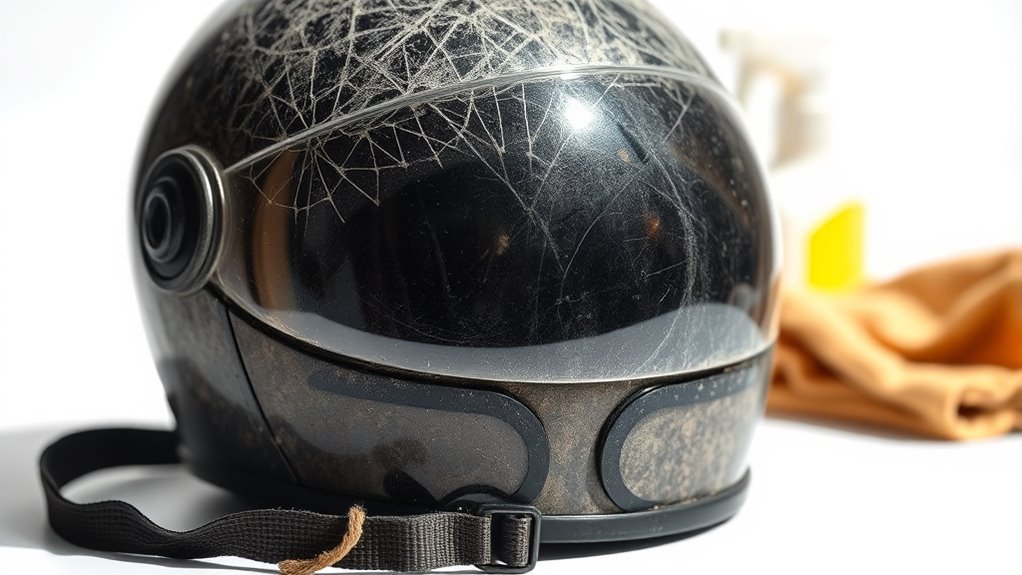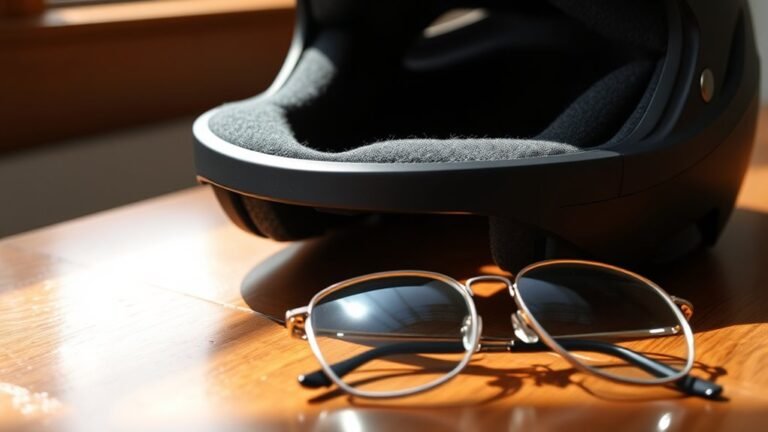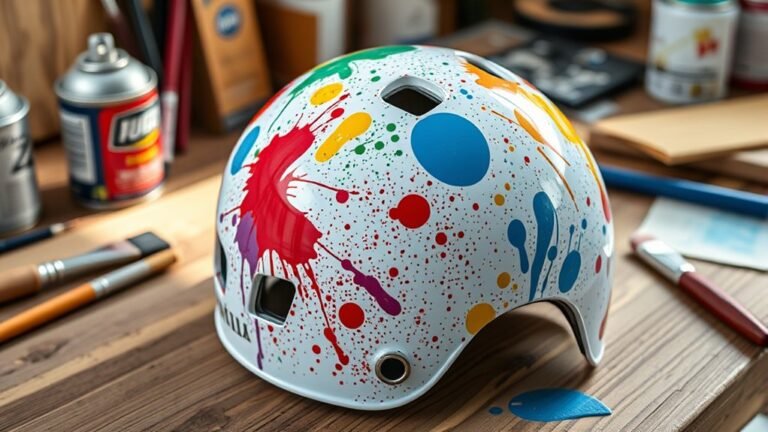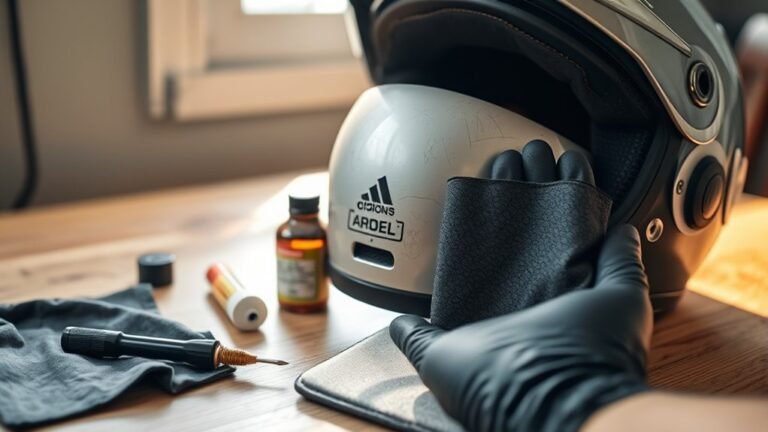Helmet Maintenance Mistakes to Avoid
When maintaining your helmet, don’t skip regular inspections or ignore expiration dates. Using harsh cleaning products can damage materials, while improper storage affects structural integrity. Always replace your helmet after an impact and check interior padding for wear. Avoid over-tightening or loosening straps, and be sure to follow manufacturer guidelines closely. Finally, don’t neglect visibility features, as they’re essential for safety. If you want to learn more about effective maintenance practices, continue exploring!
Skipping Regular Inspections
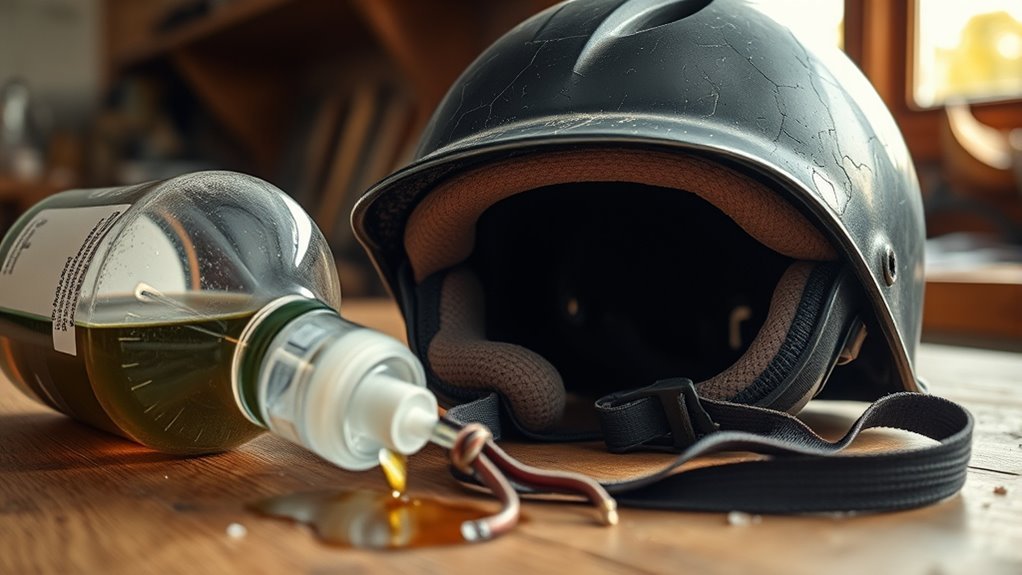
Regular inspections of your helmet are essential for ensuring its safety and effectiveness. You should establish a routine inspection frequency, ideally every month, or more often if you frequently ride. During these checks, assess the helmet condition for visible signs of damage, such as cracks, dents, or worn padding. Pay attention to the straps; they should be intact and functional. Remember, a compromised helmet can’t provide adequate protection during a fall or impact. If you notice any issues, replace the helmet immediately. Don’t underestimate the importance of these inspections; they’re your first line of defense in maintaining safety and freedom during your rides. Prioritize your helmet’s integrity to enjoy your adventures with confidence.
Using Harsh Cleaning Products
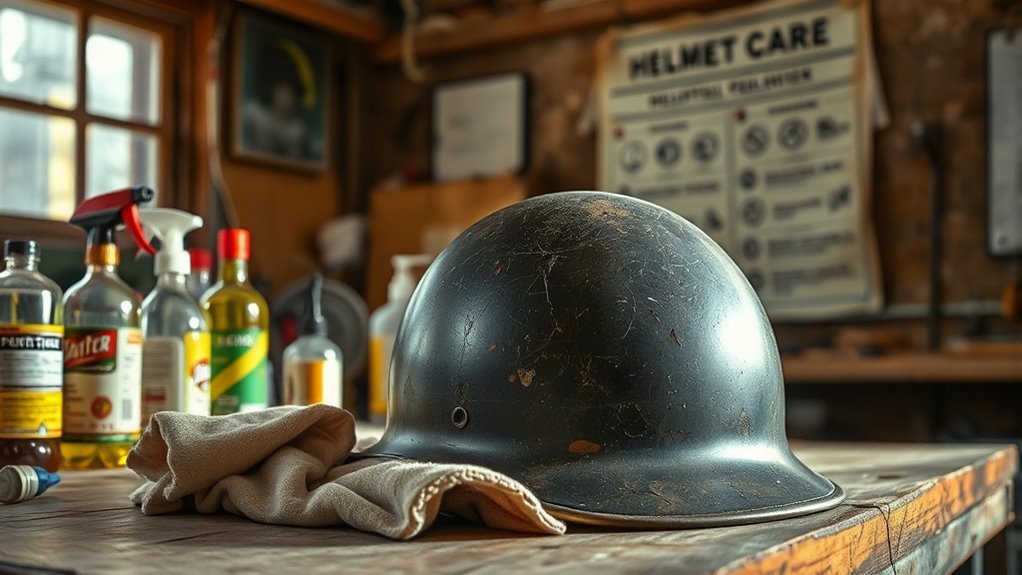
Using harsh cleaning products on your helmet can lead to chemical damage, compromising its integrity and safety. It’s essential to choose safe cleaning alternatives that effectively remove dirt without harming the materials. Always check product labels and opt for gentler solutions to guarantee your helmet remains in peak condition.
Chemical Damage Risks
While you might think that harsh cleaning products can effectively remove dirt and grime from your helmet, they can actually cause significant damage to its materials. Many helmets are constructed from various helmet material types, such as polycarbonate and fiberglass, which can degrade under chemical exposure effects. Using strong solvents or abrasive cleaners may weaken these materials, compromising the helmet’s structural integrity. Additionally, residues from these products can irritate your skin or affect your health. It’s important to remember that your helmet’s protection relies on its durability. Opting for gentler cleaning methods will guarantee your helmet remains in peak condition, safeguarding you from potential risks during your rides. Protect your investment by avoiding harsh chemicals.
Safe Cleaning Alternatives
When it comes to cleaning your helmet, opting for safe alternatives is crucial to maintaining its integrity. Avoid harsh cleaning products that can degrade materials and compromise safety. Instead, consider eco-friendly solutions like mild soap and water or specialized helmet cleaners that use alternative materials. These options effectively remove dirt and grime without risking chemical damage.
For stubborn stains, try a mixture of vinegar and water, which is safe and biodegradable. Always verify you rinse thoroughly and dry your helmet properly. Remember, using the right cleaning methods not only protects your investment but also keeps you safe on the road. By choosing safer cleaning practices, you’re preserving your helmet’s functionality and longevity while embracing an eco-conscious lifestyle.
Ignoring Expiration Dates
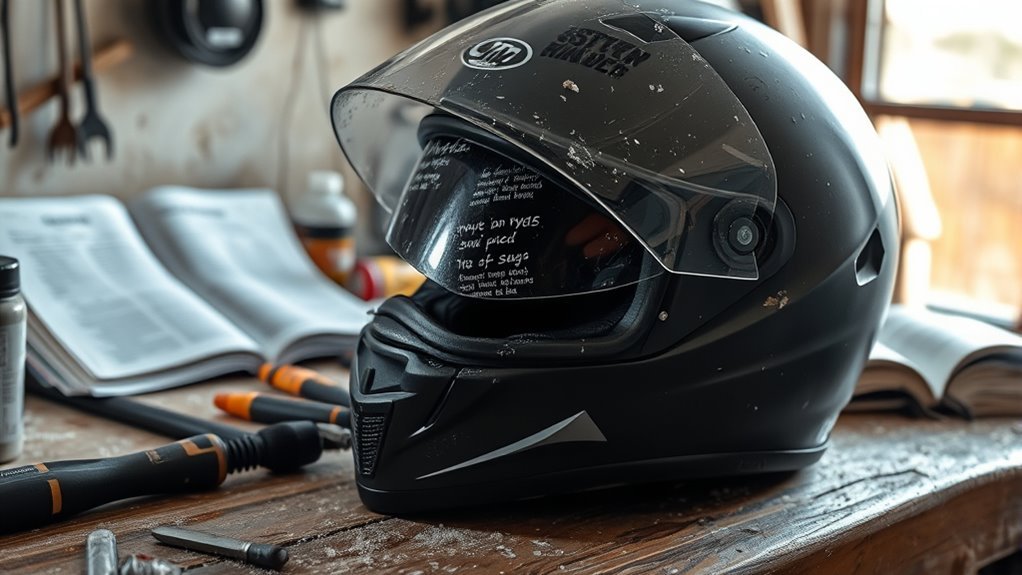
Ignoring expiration dates on your helmet can compromise your safety. Always check the manufacturer guidelines to understand when it’s time for a replacement, as materials can degrade over time, especially with frequent use. Staying aware of these factors guarantees your helmet remains effective in protecting you.
Check Manufacturer Guidelines
Failing to check the manufacturer guidelines can lead to serious safety risks, particularly when it comes to expiration dates. Each helmet is designed with specific manufacturer specifications that dictate its lifespan and safety effectiveness. Ignoring these guidelines can compromise your helmet safety and increase the likelihood of injury during an impact. Always refer to the manufacturer’s recommendations for maintenance and replacement timelines. Typically, helmets should be replaced every five to ten years, regardless of visible wear. Regularly inspect your helmet for any signs of damage, but don’t rely solely on visual assessments. Adhering to manufacturer guidelines guarantees you’re using your helmet to its fullest potential, allowing you to enjoy your freedom while staying safe on the road or trail.
Understand Material Degradation
Although you may not see visible signs of wear, understanding material degradation is essential for helmet safety. Over time, helmets can experience material fatigue due to exposure to environmental factors like UV light, moisture, and temperature fluctuations. Ignoring expiration dates can lead to compromised protection during critical moments.
| Material Type | Degradation Indicators | Recommended Action |
|---|---|---|
| EPS Foam | Cracks, dents | Replace immediately |
| Outer Shell | Fading, brittleness | Inspect regularly |
| Straps | Fraying, stiffness | Replace if damaged |
| Liners | Odor, deterioration | Clean or replace |
Always check for these indicators to guarantee your helmet remains reliable. Prioritize your safety by understanding and addressing material degradation effectively.
Recognize Usage Frequency
Regularly evaluating how often you use your helmet is essential for maintaining its protective capability. Ignoring the expiration dates, based on your helmet’s usage frequency, can compromise safety. If you ride daily, your helmet may degrade faster than if you ride occasionally. Assess your riding habits and note any signs of wear or damage, as they can indicate the need for replacement. Helmets are designed to protect against specific impacts, and repeated use can diminish their effectiveness. Remember, a helmet that’s expired or frequently used may not provide maximum protection. Make it a habit to check your helmet’s age and condition regularly, ensuring it meets safety standards and supports your freedom to ride safely.
Storing in Improper Conditions
When you store your helmet in improper conditions, you risk compromising its structural integrity and protective capabilities. Avoid exposing it to temperature extremes, as excessive heat or cold can weaken the materials. A helmet left in a car on a hot day may warp, while freezing temperatures can make it brittle. Additionally, pay attention to humidity levels; high moisture can lead to mold, which not only damages the padding but can also pose health risks. Always store your helmet in a cool, dry place, away from direct sunlight and damp areas. Use a helmet bag for added protection. By taking these simple precautions, you can make certain your helmet remains in prime condition, ready for your next adventure.
Failing to Replace After Impact
If you’ve experienced an impact while wearing your helmet, it’s crucial to replace it immediately, as the protective capabilities may be compromised. Conducting an impact assessment post-incident is essential to guarantee your safety. Remember, helmets are designed with a specific lifespan, which can be greatly reduced after a collision. Here are key points to contemplate:
- Inspect for visible damage, like cracks or dents.
- Check the helmet’s certification; some manufacturers recommend replacement after any impact.
- Reflect on the type and severity of the impact.
- Keep track of your helmet’s age; older helmets may not offer peak protection.
- Prioritize your safety—investing in a new helmet is worth it for peace of mind.
Don’t risk your safety; always replace your helmet after an impact.
Neglecting the Interior Padding
The interior padding of your helmet plays an essential role in absorbing impact and ensuring a snug fit, yet it’s often overlooked during maintenance. To maintain ideal padding hygiene, regularly inspect and clean the interior. Sweat and moisture buildup can compromise the padding’s effectiveness, leading to discomfort and reduced safety. Use mild soap and water to gently clean the padding, and allow it to air dry completely before reassembling the helmet. Neglecting this vital step can result in unpleasant odors and degraded materials. Remember, a well-maintained helmet not only enhances comfort but also maximizes protection during rides. By prioritizing the care of your helmet’s interior padding, you’re investing in your safety and freedom on the road or trail.
Over-tightening or Loosening Straps
Making sure the right fit goes beyond maintaining the interior padding; adjusting the straps is equally important for helmet safety and comfort. Over-tightening or loosening straps can compromise strap tension, leading to discomfort or reduced protection. Here are some key points to keep in mind:
Ensuring a proper helmet fit involves not just padding, but also carefully adjusting straps for optimal safety and comfort.
- Adjust straps for a snug, but not constricting fit.
- Make certain the helmet sits level on your head.
- Check that the chin strap allows for a finger-width gap.
- Regularly inspect straps for wear and tear.
- Make comfort adjustments based on your activity level.
Not Following Manufacturer Guidelines
While it may be tempting to make adjustments based on personal preference, not following manufacturer guidelines can greatly compromise helmet safety. Each helmet is engineered to meet specific helmet specifications and safety standards that guarantee maximum protection. Deviating from these guidelines can alter the helmet’s fit, reducing its effectiveness in the event of an impact. For instance, modifying the padding or ventilation might seem appealing, but it can lead to diminished shock absorption and increased risk of injury. Always refer to the manufacturer’s instructions for maintenance and adjustments. Remember, your freedom to ride depends on the proper functionality of your gear. Prioritize your safety by adhering to the established guidelines, assuring your helmet performs as intended when you need it most.
Disregarding Visibility Features
If you overlook the visibility features of your helmet, you risk compromising your safety on the road. Visibility is essential in helmet design, ensuring you’re seen by others, especially in low-light conditions. Ignoring these features can lead to dangerous situations.
Consider these visibility aspects:
- Reflective strips to enhance night visibility
- Bright colors for better daytime recognition
- Built-in lights for added illumination
- Anti-fog visors for clear peripheral vision
- Removable or adjustable visors for sun glare reduction
Frequently Asked Questions
How Often Should I Inspect My Helmet for Damage?
Inspect your helmet for damage signs like a hawk scouting for prey—frequently and thoroughly. Aim to check it every month, or more often if you ride regularly or after any impact. Look for cracks, dents, or worn padding; these can compromise safety. Don’t forget to clean it regularly, as dirt can hide damage. Keeping up with helmet inspection guarantees you’re always ready to ride with confidence and freedom.
Can I Use Vinegar for Cleaning My Helmet?
Yes, you can use vinegar for cleaning your helmet. Its acidity helps break down grime and bacteria, offering effective cleaning benefits. However, you should dilute it with water to prevent damage to the helmet’s material. If vinegar’s smell isn’t appealing, consider cleaning alternatives like mild soap or specialized helmet cleaners. Always guarantee you follow up with a thorough rinse to maintain your helmet’s integrity and guarantee a safe, enjoyable ride.
What Are the Signs of Helmet Expiration?
You should look for several expiration indicators to determine your helmet’s lifespan. Check for cracks, dents, or any visible damage to the outer shell. If the foam liner feels hard or brittle, it’s time to replace it. Additionally, if your helmet’s been involved in a significant impact, it’s essential to regard it expired, even if there’s no visible damage. Regularly inspect and replace your helmet every 3 to 5 years for ideal safety.
Is It Safe to Store My Helmet in a Car?
Storing your helmet in a car isn’t safe. Picture the sun blazing down, turning your vehicle into a sweltering oven. Car temperatures can soar, causing your helmet’s materials to degrade, compromising safety. Heat can warp the foam and weaken the outer shell, making it less effective in a crash. For ideal helmet storage, keep it in a cool, dry place, away from direct sunlight. Your safety deserves that extra care.
How Do I Know if My Helmet Fits Properly?
To know if your helmet fits properly, perform a fit assessment using a sizing guide. Place the helmet on your head, ensuring it sits level and snug without excessive pressure. The straps should form a ‘V’ under your ears, and you shouldn’t feel any movement when shaking your head. If it slides or pinches, it’s not the right size. A good fit allows freedom of movement while providing essential protection.
